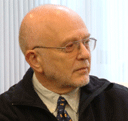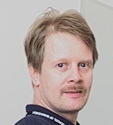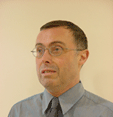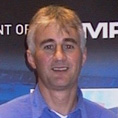 |
|
|
|
|
|
|
| |
|
|
|
| |
|
|
|
| |
Keynote Lectures will be common to both
ICSOFT and ENASE technical programs |
|
|
| |
|
|
|
| |
Keynote lectures are plenary sessions which are scheduled for taking about 45 minutes + 10 minutes for questions. |
|
|
| |
|
|
|
| |
Keynote Speakers List:
- Jan Dietz, Delft University of Technology, The Netherlands
Title: Enterprise Ontology and the Identification of Business Components
- David Lorge Parnas, University of Limerick, Ireland
Title: Document-Driven Software Design: A Novel Approach That Should Not Be Novel
- Kalle Lyytinnen, Case Western Reserve University , Canada
Title: A new look at an old problem: requirements determination and its challenges
- Stephen Mellor, Australia
Title: Creativity, Automation and Technology
- Bart Nieuwenhuis, K4B Innovation / University of Twente, The Netherlands
Title: Service Science for Market Services
- Tony Shan, Bank of America, United States
Title: Practical SOA - Brian Fitzgerald, Lero - the Irish Software Engineering Research Centre, Ireland
Title: Open Source Software Adoption in Beaumont Hospital: Anatomy of Success and Failure |
|
|
|
|
|
|
|
|
|
|
|
|
|
|
|
|
|
|
|
|
|
|
|
| Keynote Lecture 1 |
| Enterprise Ontology and the Identification of Business Components |
| |
|
|
|
 |
|
Jan Dietz,
Delft University of Technology,
The Netherlands
|
|
|
|
|
|
Brief Bio
Jan L.G. Dietz is professor in Information Systems Design at Delft University of Technology (The Netherlands). He holds a Master degree in Electrical Engineering and a Doctoral degree in Computer Science, and has practitioned business automation for 10 years. He has published over 200 scientific and professional articles as well as several books. His current research interests are in Enterprise Engineering, Enterprise Architecture and Enterprise Ontology. Jan Dietz is the spiritual father of DEMO (Design & Engineering Methodology for Organizations). He is co-founder and chairman of the DEMO Center of Expertise (www.demo.nl). He is also the leader of the Dutch national research program Extensible Architecture Framework (www.xaf.nl). His current interests concern the development of the emerging field of Enterprise Engineering. To proliferate the notion of Enterprise Engineering he has set up the international CIAO! Network (Cooperation & Interoperability – Architecture & Ontology) (www.ciao.tudelft.nl ).
Abstract:
For developing effective inter- and intra-enterprise information systems, these systems need to be modeled on a high-level of abstraction that is understood both by business people, who are defining their functionality, and software engineers, who are constructing and implementation the software systems that realize the systems functionality. The idea of business components for modeling informa-tion systems is very valuable since they directly reflect the business rules and the constraints that ap-ply to the enterprise domain (all other software components are considered either to deliver services to these business components or to offer some general functionality).
The identification of business components seems still to be in its infancy, however. The notion of en-terprise ontology, as developed at Delft University of Technology, appears to be a powerful revelation of the essence of an enterprise (or an enterprise network). The reported research seeks to improve the identification of business components based on the ontological model of an enterprise, while at the same time satisfying well-defined quality criteria. The result of applying the developed identifica-tion method are reusable and self-contained business components with well-defined interaction points that facilitate the accessing and execution of coherent packages of business functionality.
|
|
|
|
|
|
|
|
|
|
|
|
|
|
|
|
|
|
|
|
|
|
|
|
|
|
|
|
|
| Keynote Lecture 2 |
| Document-Driven Software Design: A Novel Approach That Should Not Be Novel |
 |
|
David Lorge Parnas,
University of Limerick,
Ireland
|
|
Brief Bio
David Lorge Parnas is Professor of Software Engineering, SFI Fellow and Director of the
Software Quality Research Laboratory at the University of Limerick.
Professor Parnas received his B.S., M.S. and Ph.D. in Electrical Engineering - Systems
and Communications Sciences from Carnegie Mellon University. and honorary doctorates
from the ETH in Zurich and the Catholic University of Louvain. Dr. Parnas is a Fellow of
the Royal Society of Canada and the Association for Computing Machinery (ACM) and a
Member of the Royal Irish Academy. He is licensed as a Professional Engineer in Ontario.
Professor Parnas won an ACM “Best Paper” Award in 1979, two “Most Influential Paper”
awards from the International Conference on Software Engineering, the 1998 ACM SIGSOFT
“Outstanding Research Award”, the “Practical Visionary Award” given in honor of the
late Dr.Harlan Mills, and the “Component and Object Technology” Award presented at
TOOLS99.
Parnas was the first winner of the Norbert Wiener Prize from Computing Professionals for
Social Responsibility and recently won the FifF prize from Forum Informatiker für Frieden
und Verantwortung in Germany.
Parnas is the author of more than 240 papers and reports. Many of his papers have been
republished and some are considered classics. A collection of his papers can be found in:
Hoffman, D.M., Weiss, D.M. (eds.), “Software Fundamentals: Collected Papers
by David L. Parnas”, Addison-Wesley, 2001, 664 pgs., ISBN 0-201-70369-6,.
Abstract:
In traditional Engineering disciplines, designing and documenting are interleaved with design decisions being documented and each such documented decision serving as a constraints on future decisions. Decisions may be reversed or revised but only by revising the associated documents and submitting the revisions for approval. In contrast, in Software documentation is often an afterthought and early design documents often gather dust on shelves as they are ignored.
This talk discusses and illustrates how precise design documents can be used to improve the software design process. |
|
|
|
|
|
|
|
|
|
|
|
|
|
|
|
| Keynote Lecture 3 |
| A new look at an old problem: requirements determination and its challenges |
 |
|
Kalle Lyytinnen,
Case Western Reserve University,
Canada
|
|
Brief Bio
Kalle Lyytinen is Iris S. Wolstein professor Case Western Reserve University, USA and adjunct professor at University of Jyvaskyla, Finland. He serves currently on the editorial boards of several leading IS journals including Journal of AIS (Editor-in-Chief), Journal of Strategic Information Systems, Information&Organization, Requirements Engineering Journal, Information Systems Journal, Scandinavian Journal of Information Systems, and Information Technology and People, among others. He is AIS fellow (2004), and the former chairperson of IFIP 8.2 and founding member of SIGSAND. He has published over 150 scientific articles and conference papers and edited or written ten books on topics related to nature of information disciplines, system design, method engineering, organizational implementation, risk assessment, computer supported cooperative work, standardization, and ubiquitous computing among others. He is currently involved in research projects that looks at the IT induced radical innovation in software development, IT innovation in architecture, engineering and construction industry, design and use of ubiquitous applications, requirements engineering in large and complex software initiatives, and the adoption of broadband wireless services in the U.K., South Korea and the U.S.
Abstract:
The age old adage is that good software development process starts with a good requirements determination process which states the requirements for an application in a coherent, concise and unambiguous way. This process helps determine the scope of the initiative and control the outcomes. Most of the information in requirements is expected to be found from potential users using various elicitation and requirements discovery techniques like interviewing, modelling and so on. A recent field study funded by NSF about requirements determination processes in large and complex software development environments that covered automotive, aerospace, media, telecommunication, finance and health industries and involved interviews among 25 leading experts shows a different picture of software requirements. Requirements complexity has risen to an unprecedented level and needs a new mind-set, requirements do not cover applications but sets of capabilities or processes in an enterprise, requirements are always anchored into existing legacy of capabilities and they need to address the tensions between stability and change, requirements are often driven from existing platforms and models,- not the other way round, systems have become so embedded in business processes that distinctions between functional and non-functional requirements are fictive, requirements framing is radically different between innovative and incremental changes, requirements are negotiated within the scope of project time, risk and scope, and requirements are not fixed but remain volatile for longer periods of time. We also observe, that contrary to academics belief, the challenge is not in the methods to find out and describe systems, but to scale up and relate system models to the other elements in the environment. We discuss challenges associated with these findings and suggest some future research avenues to address those challenges. |
|
|
|
|
|
|
|
|
|
|
| Keynote Lecture 4 |
| Creativity, Automation and Technology |
 |
Stephen Mellor,
Australia
|
|
Brief Bio
Stephen J. Mellor is an internationally recognized pioneer in creating effective, engineering approaches to software development. In 1985, he published the widely read Ward-Mellor trilogy Structured Development for Real-Time Systems, and in 1988, the first books defining object-oriented analysis. Stephen also published Executable UML: A Foundation for Model-Driven Architecture in 2002. His latest book MDA Distilled: Principles of Model-Driven Architecture was published in 2004.
He is active in the Object Management Group, chairing the consortium that added executable actions to the UML. He is is now working on the executable UML foundation standard at the OMG. Perhaps surprisingly, he is also a signatory to the Agile Manifesto.
Stephen acts as Chair of the IEEE Software Advisory Board, and is an adjunct professor at the Australian National University.
Abstract:
As we raise the level of abstraction, technology becomes hidden (look at ASICs in the hardware world, or dialling a phone call). To effect this hiding of technology we automate, and the better the automation, the better hidden the underlying technology can be. Today, we use programming languages at various levels of sophistication, but that leaves open the question of how we create the conceptual entities therein. How much can that be automated? How complete should that automation be? How far can we go? How well can we teach the creativity involved in abstraction? This keynote will raise these questions, among others, focussing on the several areas targetted by the conference, and offer answers.
|
|
|
|
|
|
|
|
|
|
|
| Keynote Lecture 5 |
| Service Science for Market Services |
 |
|
Bart Nieuwenhuis,
K4B Innovation / University of Twente,
The Netherlands
|
|
|
|
|
|
Brief Bio
Bart Nieuwenhuis works for his own consultancy firm K4B Innovation and is professor at the University of Twente. He is advisor to the Netherlands ICT Research and Innovation Authority and chairman of the innovation-driven research programme Generic Communication, part of R&D programmes funded by the Ministry of Economic Affaires. He is setting up the European Service Innovation Centre, an initiative to support innovations of the service industry in The Netherlands. He is developing business models supporting the assessment of ICT projects in Health Care. In the past, he worked on projects on the introduction of the Public Transport Chip Card in the Netherlands and a nation wide system for payments through mobile phones and the Internet. Since 2000, Bart Nieuwenhuis holds a chair in the Service Architecture Group at the Computer Science Department of the University of Twente. He supervises PhD students and publishes scientific articles and conference papers on services provisioning platforms and middleware technologies for quality of service and context awareness. He joined the group in Twente after a period of five years at the University of Groningen, where he was tele-informatics professor at the Computer Science Faculty. Bart Nieuwenhuis is an invited speaker on conferences and guest lecturer for universities in the Netherlands and abroad. Before starting his own company, he worked more than 20 years for KPN Research, the R&D facility of KPN, the telephony and Internet market leader in The Netherlands. He served as manager of R&D departments and Head of Strategy of KPN Research. Bart Nieuwenhuis worked on behave of KPN for the European Institute for Research and Strategic Studies in Telecommunications (EURESCOM) in Heidelberg and was leader of various international, cooperative projects of European public network operators. Bart Nieuwenhuis holds a PhD in Computer Science and a MSc (cum laude) and BSc in Electrical Engineering, all from the University of Twente.
Abstract: The market service share in Western European economies is growing at cost of agriculture and manufacturing. More than seventy percent of employment and economic growth is due to growth of market services. According to various reports, productivity growth of market services through the use of ICT in Europe is lagging behind that of the US during the last five years. Hence, companies in Europe seem to benefit less from ICT than companies in the US. A vast number of studies show that innovations of products and services are not only driven by technological innovations but also depend on other determinants like organisational changes, structural changes, attitude against experiments and the availability of competent human resources. In European countries both, organisations in the private and public sector, don’t take advantage of their strong position on communication infrastructure, e.g., the high penetration of broadband Internet connections and mobile phones. Controversy exists about possible differences between innovations of products and innovations of services. Research shows that market service industry invests more on innovations than generally thought but is less strong connected to the knowledge infrastructure than the manufacturing industry. This talk elaborates on these issues using practical examples and presents the results of a study identifying ways how public and private organisations may benefit from available knowledge produced by technological, social, economic and management sciences. |
|
|
|
|
|
|
|
|
|
|
|
|
|
|
|
|
|
|
|
|
|
|
|
|
| Keynote Lecture 6 |
| Practical SOA |
 |
|
Tony Shan,
Bank of America,
USA
|
|
|
|
|
|
Brief Bio
Tony
Shan is a renowned expert working in the computing field for 20+ years with extensive experience on architecture engineering, technology strategies, and system designs in a number of multi-million dollar IT projects in a broad range of industries (finance/banking, telecommunications, mechanical engineering, aerospace, textile engineering, and government). He holds three advanced degrees in Engineering and Science majors, and is a Sun Certified Enterprise Architect & Java Programmer, and IBM Certified eBusiness Solution Designer. Having been involved in web technologies since the earliest Html, Java and .Net versions, he has, as an enterprise/solutions/chief architect, directed the lifecycle design and development of large-scale award-winning distributed systems on diverse platforms using a variety of cutting-edge technologies and unified/agile methodologies. He has initiated advanced research on emerging computing technologies (grid computing, design patterns, frameworks, semantic web, machine learning, neural network, expert system, generic/immune algorithm, computer modeling/simulation, telephony/voice response, pervasive computing, and systems engineering automation), resulting in an invention patent and several patent-pending initiatives as well as many unified methodologies and platform models for adaptive enterprise system development. He has played a chief strategist role in leading establishing IT strategies and architecture blueprints, coupled with pragmatic technology roadmaps and enterprise architecture standards/policies, for IT governance and portfolio/asset management in Fortune 100 international organizations.
He serves as a mentor/advisor on leading-edge technologies, architecture, and engineering in various technical committees, and teaches a wide variety of courses as an adjunct professor and professional trainer. In addition to dozens of top-notch technical publications, he has authored several books on asynchronous web services and heterogeneous business integration, and is working on multiple books on Internet technologies. He is a member of numerous professional associations and honorary society, a frequent speaker and Chair/Program Committee member in key IEEE/ACM conferences/workshops, an editor/editorial advisory board member of IT research journals & books, as well as a founder of Greater Charlotte Rational User Group and Charlotte Architecture & Technology Symposium.
Abstract: In this lecture, a practical method is presented to effectively cope with the complexity of service-oriented architecture design and the lifecycle of service-oriented solutions development. This method consists of seven major elements: Reference model, Optimization, Architecture, Discipline, Maturity, Automation and Platform (ROADMAP). The key SOA issues are addressed, such as fragmented specifications efforts, immature technologies, and non-standard visual diagramming. The goal of this comprehensive approach is to filter the inessential from the essential with a mature integration of appropriate knowledge and capabilities. Best practices are discussed in the context.
|
|
|
|
|
|
|
|
|
|
|
|
|
|
|
| Keynote Lecture 7 |
| Open Source Software Adoption in Beaumont Hospital: Anatomy of Success and Failure |
 |
|
Brian Fitzgerald,
Lero - the Irish Software Engineering Research Centre,
Ireland
|
|
|
|
|
|
Brief Bio
Brian Fitzgerald holds an endowed professorship, the Frederick A Krehbiel II Chair in Innovation in Global Business & Technology, at the University of Limerick, Ireland, where he is also Research Fellow, Science Foundation Ireland Principal Investigator, and Research Leader for Global Software Development at Lero – the Irish Software Engineering Research Centre. He was formerly at University College Cork, and held positions as Visiting Professor in the US, Sweden and the UK. He received his PhD from the University of London and his research interests lie primarily in the area of software development, a broad area which encompasses the use of development methods, globally-distributed software development, agile methods and open source software. His publications include eight books, and more than 100 papers in leading international journals and conferences in both the Information Systems and Software Engineering fields. Having worked in industry prior to taking up an academic position, he has more than 20 years experience in the software field. This experience was gained in a variety of industry sectors (telecoms, manufacturing, financial services, education and software houses) in a number of countries (Ireland, UK, Belgium, Germany). He has also been successful in a number of research funding proposals from the European Commission, Science Foundation Ireland and Enterprise Ireland. Overall, these projects have received funding in excess of €15 million.
Abstract: Current estimates suggest widespread adoption of open source software (OSS) in organizations worldwide. However, the problematic nature of OSS adoption is readily evidenced in the fairly frequent reports of problems, unforeseen hold-ups, and outright abandonment of OSS implementation over time. Beaumont Hospital, an Irish public sector organization, have embarked on the adoption of a range of OSS applications over several years, some of which have been successfully deployed and remain in live use within the organisation, whereas others, despite achieving high levels of assimilation over a number of years, have not been ultimately retained in live use in the organization. Using a longitudinal case study, we discuss in depth the deployment process for two OSS applications – the desktop application suite whose deployment was unsuccessful ultimately, and the email application which was successfully deployed. To our knowledge, this is the first such in-depth study into successful and unsuccessful OSS implementation. Given that our study was a longitudinal one in a single organization, we can control a number of potentially important influencing elements which would not be possible if multiple organizations were involved. In particular, the complex interaction of issues to do with voluntariness of adoption, image, trialability and absorptive capacity were critical influences in the process. |
|
|
|
|
| ................................................................................................................................................................................................................................................... |
|
|
|
|
Copyright © INSTICC
Page updated on 17/12/09
|
|
|
|
|
|
|
|







